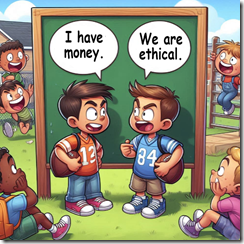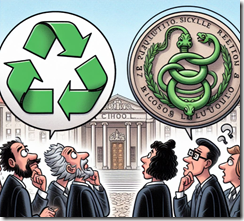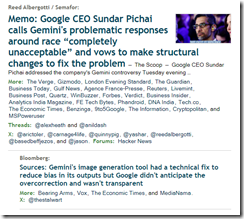US Government Procurement: Long Live Silos
September 12, 2024
 This essay is the work of a dumb dinobaby. No smart software required.
This essay is the work of a dumb dinobaby. No smart software required.
I read “Defense AI Models A Risk to Life Alleges Spurned Tech Firm.” Frankly , the headline made little sense to me so I worked through what is a story about a contractor who believes it was shafted by a large consulting firm. In my experience, the situation is neither unusual nor particularly newsworthy. The write up does a reasonable job of presenting a story which could have been titled “Naive Start Up Smoked by Big Consulting Firm.” A small high technology contractor with smart software hooks up with a project in the Department of Defense. The high tech outfit is not able to meet the requirements to get the job. The little AI high tech outfit scouts around and brings a big consulting firm to get the deal done. After some bureaucratic cycles, the small high tech outfit is benched. If you are not familiar with how US government contracting works, the write up provides some insight.
The work product of AI projects will be digital silos. That is the key message of this procurement story. I don’t feel sorry for the smaller company. It did not prepare itself to deal with the big time government contractor. Outfits are big for a reason. They exploit opportunities and rarely emulate Mother Theresa-type behavior. Thanks, MSFT Copilot. Good enough illustration although the robots look stupid.
For me, the article is a stellar example of how information or or AI silos are created within the US government. Smart software is hot right now. Each agency, each department, and each unit wants to deploy an AI enabled service. Then that AI infused service becomes (one hopes) an afterburner for more money with which one can add headcount and more AI technology. AI is a rare opportunity to become recognized as a high-performance operator.
As a result, each AI service is constructed within a silo. Think about a structure designed to hold that specific service. The design is purpose built to keep rats and other vermin from benefiting from the goodies within the AI silo. Despite the talk about breaking down information silos, silos in a high profile, high potential technical are like artificial intelligence are the principal product of each agency, each department, and each unit. The payoff could be a promotion which might result in a cushy job in the commercial AI sector or a golden ring; that is, the senior executive service.
I understand the frustration of the small, high tech AI outfit. It knows it has been played by the big consulting firm and the procurement process. But, hey, there is a reason the big consulting firm generates billions of dollars in government contracts. The smaller outfit failed to lock down its role, retain the key to the know how it developed, and allowed its “must have cachè” to slip away.
Welcome, AI company, to the world of the big time Beltway Bandit. Were you expecting the big time consulting firm to do what you wanted? Did you enter the deal with a lack of knowledge, management sophistication, and a couple of false assumptions? And what about the notion of “algorithmic warfare”? Yeah, autonomous weapons systems are the future. Furthermore, when autonomous systems are deployed, the only way they can be neutralized is to use more capable autonomous weapons. Does this sound like a reply of the logic of Cold War thinking and everyone’s favorite bedtime read On Thermonuclear War still available on Amazon and as of September 6, 2024, on the Internet Archive at this link.
Several observations are warranted:
- Small outfits need to be informed about how big consulting companies with billions in government contracts work the system before exchanging substantive information
- The US government procurement processes are slow to change, and the Federal Acquisition Regulations and related government documents provide the rules of the road. Learn them before getting too excited about a request for a proposal or Federal Register announcement
- In a fight with a big time government contractor make sure you bring money, not a chip on your shoulder, to the meeting with attorneys. The entity with the most money typically wins because legal fees are more likely to kill a smaller firm than any judicial or tribunal ruling.
Net net: Silos are inherent in the work process of any government even those run by different rules. But what about the small AI firm’s loss of the contract? Happens so often, I view it as a normal part of the success workflow. Winners and losers are inevitable. Be smarter to avoid losing.
Stephen E Arnold, September 12, 2024
AI Safety Evaluations, Some Issues Exist
August 14, 2024
Ah, corporate self regulation. What could go wrong? Well, as TechCrunch reports, “Many Safety Evaluations for AI Models Have Significant Limitations.” Writer Kyle Wiggers tells us:
“Generative AI models … are coming under increased scrutiny for their tendency to make mistakes and generally behave unpredictably. Now, organizations from public sector agencies to big tech firms are proposing new benchmarks to test these models’ safety. Toward the end of last year, startup Scale AI formed a lab dedicated to evaluating how well models align with safety guidelines. This month, NIST and the U.K. AI Safety Institute released tools designed to assess model risk. But these model-probing tests and methods may be inadequate. The Ada Lovelace Institute (ALI), a U.K.-based nonprofit AI research organization, conducted a study that interviewed experts from academic labs, civil society and those who are producing vendors models, as well as audited recent research into AI safety evaluations. The co-authors found that while current evaluations can be useful, they’re non-exhaustive, can be gamed easily and don’t necessarily give an indication of how models will behave in real-world scenarios.”
There are several reasons for the gloomy conclusion. For one, there are no established best practices for these evaluations, leaving each organization to go its own way. One approach, benchmarking, has certain problems. For example, for time or cost reasons, models are often tested on the same data they were trained on. Whether they can perform in the wild is another matter. Also, even small changes to a model can make big differences in behavior, but few organizations have the time or money to test every software iteration.
What about red-teaming: hiring someone to probe the model for flaws? The low number of qualified red-teamers and the laborious nature of the method make it costly, out of reach for smaller firms. There are also few agreed-upon standards for the practice, so it is hard to assess the effectiveness of red-team projects.
The post suggests all is not lost—as long as we are willing to take responsibility for evaluations out of AI firms’ hands. Good luck prying open that death grip. Government regulators and third-party testers would hypothetically fill the role, complete with transparency. What a concept. It would also be good to develop standard practices and context-specific evaluations. Bonus points if a method is based on an understanding of how each AI model operates. (Sadly, such understanding remains elusive.)
Even with these measures, it may never be possible to ensure any model is truly safe. The write-up concludes with a quote from the study’s co-author Mahi Hardalupas:
“Determining if a model is ‘safe’ requires understanding the contexts in which it is used, who it is sold or made accessible to, and whether the safeguards that are in place are adequate and robust to reduce those risks. Evaluations of a foundation model can serve an exploratory purpose to identify potential risks, but they cannot guarantee a model is safe, let alone ‘perfectly safe.’ Many of our interviewees agreed that evaluations cannot prove a model is safe and can only indicate a model is unsafe.”
How comforting.
Cynthia Murrell, August 14, 2024
Which Outfit Will Win? The Google or Some Bunch of Busy Bodies
July 30, 2024
 This essay is the work of a dumb humanoid. No smart software required.
This essay is the work of a dumb humanoid. No smart software required.
It may not be the shoot out at the OK Corral, but the dust up is likely to be a fan favorite. It is possible that some crypto outfit will find a way to issue an NFT and host pay-per-view broadcasts of the committee meetings, lawyer news conferences, and pundits recycling press releases. On the other hand, maybe the shoot out is a Hollywood deal. Everyone knows who is going to win before the real action begins.
“Third Party Cookies Have Got to Go” reports:
After reading Google’s announcement that they no longer plan to deprecate third-party cookies, we wanted to make our position clear. We have updated our TAG finding Third-party cookies must be removed to spell out our concerns.
A great debate is underway. Who or what wins? Experience suggests that money has an advantage in this type of disagreement. Thanks, MSFT. Good enough.
Who is making this draconian statement? A government regulator? A big-time legal eagle representing an NGO? Someone running for president of the United States? A member of the CCP? Nope, the World Wide Web Consortium or W3C. This group was set up by Tim Berners-Lee, who wanted to find and link documents at CERN. The outfit wants to cook up Web standards, much to the delight of online advertising interests and certain organizations monitoring Web traffic. Rules allow crafting ways to circumvent their intent and enable the magical world of the modern Internet. How is that working out? I thought the big technology companies set standards like no “soft 404s” or “sorry, Chrome created a problem. We are really, really sorry.”
The write up continues:
We aren’t the only ones who are worried. The updated RFC that defines cookies says that third-party cookies have “inherent privacy issues” and that therefore web “resources cannot rely upon third-party cookies being treated consistently by user agents for the foreseeable future.” We agree. Furthermore, tracking and subsequent data collection and brokerage can support micro-targeting of political messages, which can have a detrimental impact on society, as identified by Privacy International and other organizations. Regulatory authorities, such as the UK’s Information Commissioner’s Office, have also called for the blocking of third-party cookies.
I understand, but the Google seems to be doing one of those “let’s just dump this loser” moves. Revenue is more important than the silly privacy thing. Users who want privacy should take control of their technology.
The W3C points out:
The unfortunate climb-down will also have secondary effects, as it is likely to delay cross-browser work on effective alternatives to third-party cookies. We fear it will have an overall detrimental impact on the cause of improving privacy on the web. We sincerely hope that Google reverses this decision and re-commits to a path towards removal of third-party cookies.
Now the big question: “Who is going to win this shoot out?”
Normal folks might compromise or test a number of options to determine which makes the most sense at a particularly interesting point in time. There is post-Covid weirdness, the threat of escalating armed conflict in what six, 27, or 95 countries, and financial brittleness. That anti-fragile handwaving is not getting much traction in my opinion.
At one end of the corral are the sleek, technology wizards. These norm core folks have phasers, AI, and money. At the other end of the corral are the opponents who look like a random selection of Café de Paris customers. Place you bets.
Stephen E Arnold, July 30, 2024
.
Harvard University: A Sticky Wicket, Right, Old Chap?
April 22, 2024
 This essay is the work of a dumb dinobaby. No smart software required.
This essay is the work of a dumb dinobaby. No smart software required.
I know plastic recycling does not work. The garbage pick up outfit assures me it recycles. Yeah, sure. However, I know one place where recycling is alive and well. I watched a video about someone named Francesca Gino, a Harvard professor. A YouTuber named Pete Judo presents information showing that Ms. Gino did some recycling. He did not award her those little green Ouroboros symbols. Copying and pasting are out of bounds in the Land of Ivory Towers in which Harvard has allegedly the ivory-est. You can find his videos at https://www.youtube.com/@PeteJudo1.
The august group of academic scholars are struggling to decide which image best fits the 21st-century version of their prestigious university: The garbage recycling image representing reuse of trash generated by other scholars or the snake-eating-its-tail image of the Ouroboros. So many decisions have these elite thinkers. Thanks, MSFT Copilot. Looking forward to your new minority stake in a company in a far off land?
As impressive a source as a YouTuber is, I think I found an even more prestigious organ of insight, the estimable New York Post. Navigate through the pop ups until you see the “real” news story “Harvard Medical School Professor Massively Plagiarized Report for Lockheed Martin Suit: Judge.” The thrust of this story is that a moonlighting scholar “plagiarized huge swaths of a report he submitted on carcinogenic chemicals, according to a federal judge, who agreed to remove it as evidence in a class action case against Lockheed Martin.”
Is this Medical School-related item spot on? I don’t know. Is the Gino-us activity on the money? For that matter, is a third Harvard professor of ethics guilty of an ethical violation in a journal article about — wait for it — ethics? I don’t know, and I don’t have the energy to figure out if plagiarism is the new Covid among academics in Boston.
However, based on the drift of these examples, I can offer several observations:
- Harvard University has a public relations problem. Judging from the coverage in outstanding information services as YouTube and the New York Post, the remarkable school needs to get its act together and do some “messaging.” When the plagiarism pandemic is real or fabricated by the type of adversary Microsoft continually says creates trouble, Harvard’s reputation is going to be worn down by a stream of digital bad news.
- The ways of a most Ivory Tower thing are mysterious. Nevertheless, it is clear that the mechanism for hiring, motivating, directing, and preventing academic superstars from sticking their hand in a pile of dog doo is not working. That falls into what I call “governance.” I want to use my best Harvard rhetoric now: “Hey, folks, you ain’t making good moves.”
- The top dog (president, CFO, bursar, whatever) you are on the path to an “F.” Imagine what a moral stick in the mud like William James would think of Harvard’s leadership if he were still waddling around, mumbling about radical pragmatism. Even more frightening is an AI version of this sporty chap doing a version of AI Jesus on Twitch. Instead of recycling Christian phrases, he would combine his thoughts about ethics, psychology, and Harvard with the possibly true stories about Harvard integrity herpes. Yikes.
Net net: What about educating tomorrow’s leaders. Should these young minds emulate what professors are doing, or should they be learning to pursue knowledge without shortcuts, cheating, plagiarism, and looking like characters from The Simpsons?
Stephen E Arnold, April 22, 2024
Google Gem: Arresting People Management
April 18, 2024
 This essay is the work of a dumb dinobaby. No smart software required.
This essay is the work of a dumb dinobaby. No smart software required.
I have worked for some well-managed outfits: Halliburton, Booz Allen, Ziff Communications, and others in the 55 year career. The idea that employees at Halliburton Nuclear (my assignment) would occupy the offices of a senior officer like Eugene Saltarelli was inconceivable. (Mr. Saltarelli sported a facial scar. When asked about the disfigurement, he would stare at the interlocutor and ask, “What scar?” Do you want to “take over” his office?) Another of my superiors at a firm in New York had a special method of shaping employee behavior. This professional did nothing to suppress rumors that two of his wives drowned during “storms” after falling off his sail boat. Did I entertain taking over his many-windowed office in Manhattan? Answer: Are you sure you internalized the anecdote?
Another Google management gem glitters in the public spot light.
But at the Google life seems to be different, maybe a little more frisky absent psychological behavior controls. I read “Nine Google Workers Get Arrested After Sit-In Protest over $1.2B Cloud Deal with Israel.” The main idea seems to be that someone at Google sold cloud services to the Israeli government. Employees apparently viewed the contract as bad, wrong, stupid, or some combination of attributes. The fix involved a 1960s-style sit in. After a period of time elapsed, someone at Google called the police. The employee-protesters were arrested.
I recall hearing years ago that Google faced a similar push back about a contract with the US government. To be honest, Google has generated so many human resource moments, I have a tough time recalling each. A few are Mt. Everests of excellence; for example, the termination of Dr. Timnit Gebru. This Googler had the nerve to question the bias of Google’s smart software. She departed. I assume she enjoyed the images of biased signers of documents related to America’s independence and multi-ethnic soldiers in the World War II German army. Bias? Google thinks not I guess.
The protest occurs as the Google tries to cope with increased market pressure and the tough-to-control costs of smart software. The quick fix is to nuke or RIF employees. “Google Lays Off Workers As Part of Pretty Large-Scale Restructuring” reports by citing Business Insider:
Ruth Porat, Google’s chief financial officer, sent an email to employees announcing that the company would create “growth hubs” in India, Mexico and Ireland. The unspecified number of layoffs will affect teams in the company’s finance department, including its treasury, business services and revenue cash operations units
That looks like off-shoring to me. The idea was a cookie cutter solution spun up by blue chip consulting companies 20, maybe 30 years ago. On paper, the math is more enticing than a new Land Rover and about as reliable. A state-side worker costs X fully loaded with G&A, benefits, etc. An off-shore worker costs X minus Y. If the delta means cost savings, go for it. What’s not to like?
According to a source cited in the New York Post:
“As we’ve said, we’re responsibly investing in our company’s biggest priorities and the significant opportunities ahead… To best position us for these opportunities, throughout the second half of 2023 and into 2024, a number of our teams made changes to become more efficient and work better, remove layers and align their resources to their biggest product priorities.
Yep, align. That senior management team has a way with words.
Will those who are in fear of their jobs join in the increasingly routine Google employee protests? Will disgruntled staff sandbag products and code? Will those who are terminated write tell-alls about their experiences at an outfit operating under Code Red for more than a year?
Several observations:
- Microsoft’s quite effective push of its AI products and services continues. In certain key markets like New York City and the US government, Google is on the defensive. Hint: Microsoft has the advantage, and the Google is struggling to catch up.
- Google’s management of its personnel seems to create the wrong type of news. Example: Staff arrests. Is that part of Peter Drucker’s management advice.
- The Google leadership team appears to lack the ability to do their job in a way that operates in a quiet, effective, positive, and measured way.
Net net: The online ad money machine keeps running. But if the investigations into Google’s business practices get traction, Google will have additional challenges to face. The Sundar & Prabhakar Comedy team should make a TikTok-type, how-to video about human resource management. I would prefer a short video about the origin story for the online advertising method which allowed Google to become a fascinating outfit.
Stephen E Arnold, April 18, 2024
Philosophy and Money: Adam Smith Remains Flexible
March 6, 2024
 This essay is the work of a dumb dinobaby. No smart software required.
This essay is the work of a dumb dinobaby. No smart software required.
In the early twenty-first century, China was slated to overtake the United States as the world’s top economy. Unfortunately for the “sleeping dragon,” China’s economy has tanked due to many factors. The country, however, still remains a strong spot for technology development such as AI and chips. The Register explains why China is still doing well in the tech sector: “How Did China Get So Good At Chips And AI? Congressional Investigation Blames American Venture Capitalists.”
Venture capitalists are always interested in increasing their wealth and subverting anything preventing that. While the US government has choked China’s semiconductor industry and denying it the use of tools to develop AI, venture capitalists are funding those sectors. The US’s House Select Committee on the China Communist Party (CCP) shared that five venture capitalists are funneling billions into these two industries: Walden International, Sequoia Capital, Qualcomm Ventures, GSR Ventures, and GGV Capital. Chinese semiconductor and AI businesses are linked to human rights abuses and the People’s Liberation Army. These five venture capitalist firms don’t appear interested in respecting human rights or preventing the spread of communism.
The House Select Committee on the CCP discovered that one $1.9 million went to AI companies that support China’s mega-surveillance state and aided in the Uyghur genocide. The US blacklisted these AI-related companies. The committee also found that $1.2 bullion was sent to 150 semiconductor companies.
The committee also accused of sharing more than funding with China:
“The committee also called out the VCs for "intangible" contributions – including consulting, talent acquisition, and market opportunities. In one example highlighted in the report, the committee singled out Walden International chairman Lip-Bu Tan, who previously served as the CEO of Cadence Design Systems. Cadence develops electronic design automation software which Chinese corporates, like Huawei, are actively trying to replicate. The committee alleges that Tan and other partners at Walden coordinated business opportunities and provided subject-matter expertise while holding board seats at SMIC and Advanced Micro-Fabrication Equipment Co. (AMEC).”
Sharing knowledge and business connections is equally bad (if not worse) than funding China’s tech sector. It’s like providing instructions and resources on how to build nuclear weapon. If China only had the resources it wouldn’t be as frightening.
Whitney Grace, March 6, 2024
The Google: A Bit of a Wobble
February 28, 2024
 This essay is the work of a dumb humanoid. No smart software required.
This essay is the work of a dumb humanoid. No smart software required.
Check out this snap from Techmeme on February 28, 2024. The folks commenting about Google Gemini’s very interesting picture generation system are confused. Some think that Gemini makes clear that the Google has lost its way. Others just find the recent image gaffes as one more indication that the company is too big to manage and the present senior management is too busy amping up the advertising pushed in front of “users.”
I wanted to take a look at What Analytics India Magazine had to say. Its article is “Aal Izz Well, Google.” The write up — from a nation state some nifty drone technology and so-so relationships with its neighbors — offers this statement:
In recent weeks, the situation has intensified to the extent that there are calls for the resignation of Google chief Sundar Pichai. Helios Capital founder Samir Arora has suggested a likelihood of Pichai facing termination or choosing to resign soon, in the aftermath of the Gemini debacle.
The write offers:
Google chief Sundar Pichai, too, graciously accepted the mistake. “I know that some of its responses have offended our users and shown bias – to be clear, that’s completely unacceptable and we got it wrong,” Pichai said in a memo.
The author of the Analytics India article is Siddharth Jindal. I wonder if he will talk about Sundar’s and Prabhakar’s most recent comedy sketch. The roll out of Bard in Paris was a hoot, and it too had gaffes. That was a year ago. Now it is a year later and what’s Google accomplished:
Analytics India emphasizes that “Google is not alone.” My team and I know that smart software is the next big thing. But Analytics India is particularly forgiving.
The estimable New York Post takes a slightly different approach. “Google Parent Loses $70B in Market Value after Woke AI Chatbot Disaster” reports:
Google’s parent company lost more than $70 billion in market value in a single trading day after its “woke” chatbot’s bizarre image debacle stoked renewed fears among investors about its heavily promoted AI tool. Shares of Alphabet sank 4.4% to close at $138.75 in the week’s first day of trading on Monday. The Google’s parent’s stock moved slightly higher in premarket trading on Tuesday [February 28, 2024, 941 am US Eastern time].
As I write this, I turned to Google’s nemesis, the Softies in Redmond, Washington. I asked for a dinosaur looking at a meteorite crater. Here’s what Copilot provided:
Several observations:
- This is a spectacular event. Sundar and Prabhakar will have a smooth explanation I believe. Smooth may be their core competency.
- The fact that a Code Red has become a Code Dead makes clear that communications at Google requires a tune up. But if no one is in charge, blowing $70 billion will catch the attention of some folks with sharp teeth and a mean spirit.
- The adolescent attitudes of a high school science club appear to inform the management methods at Google. A big time investigative journalist told me that Google did not operate like a high school science club planning a bus trip to the state science fair. I stick by my HSSCMM or high school science club management method. I won’t repeat her phrase because it is similar to Google’s quantumly supreme smart software: Wildly off base.
Net net: I love this rationalization of management, governance, and technical failure. Everyone in the science club gets a failing grade. Hey, wizards and wizardettes, why not just stick to selling advertising.
Stephen E Arnold, February 28,. 2024
What Techno-Optimism Seems to Suggest (Oligopolies, a Plutocracy, or Utopia)
February 23, 2024
 This essay is the work of a dumb dinobaby. No smart software required.
This essay is the work of a dumb dinobaby. No smart software required.
Science and mathematics are comparable to religion. These fields of study attract acolytes who study and revere associated knowledge and shun nonbelievers. The advancement of modern technology is its own subset of religious science and mathematics combined with philosophical doctrine. Tech Policy Press discusses the changing views on technology-based philosophy in: “Parsing The Political Project Of Techno-Optimism.”
Rich, venture capitalists Marc Andreessen and Ben Horowitz are influential in Silicon Valley. While they’ve shaped modern technology with their investments, they also tried drafting a manifesto about how technology should be handled in the future. They “creatively” labeled it the “techno-optimist manifesto.” It promotes an ideology that favors rich people increasing their wealth by investing in politicians that will help them achieve this.
Techno-optimism is not the new mantra of Silicon Valley. Reception didn’t go over well. Andreessen wrote:
“Techno-Optimism is a material philosophy, not a political philosophy…We are materially focused, for a reason – to open the aperture on how we may choose to live amid material abundance.”
He also labeled this section, “the meaning of life.”
Techno-optimism is a revamped version of the Californian ideology that reigned in the 1990s. It preached that the future should be shaped by engineers, investors, and entrepreneurs without governmental influence. Techno-optimism wants venture capitalists to be untaxed with unregulated portfolios.
Horowitz added his own Silicon Valley-type titbit:
“‘…will, for the first time, get involved with politics by supporting candidates who align with our vision and values specifically for technology. (…) [W]e are non-partisan, one issue voters: if a candidate supports an optimistic technology-enabled future, we are for them. If they want to choke off important technologies, we are against them.’”
Horowitz and Andreessen are giving the world what some might describe as “a one-finger salute.” These venture capitalists want to do whatever they want wherever they want with governments in their pockets.
This isn’t a new ideology or a philosophy. It’s a rebranding of socialism and fascism and communism. There’s an even better word that describes techno-optimism: Plutocracy. I am not sure the approach will produce a Utopia. But there is a good chance that some giant techno feudal outfits will reap big rewards. But another approach might be to call techno optimism a religion and grab the benefits of a tax exemption. I wonder if someone will create a deep fake of Jim and Tammy Faye? Interesting.
Whitney Grace, February 23, 2023
Did Pandora Have a Box or Just a PR Outfit?
February 21, 2024
 This essay is the work of a dumb dinobaby. No smart software required.
This essay is the work of a dumb dinobaby. No smart software required.
I read (after some interesting blank page renderings) Gizmodo’s “Want Gemini and ChatGPT to Write Political Campaigns? Just Gaslight Them.” That title obscures the actual point of the write up. But, the subtitle nails the main point of the write up; specifically:
Google and OpenAI’s chatbots have almost no safeguards against creating AI disinformation for the 2024 presidential election.
Thanks, Google ImageFX. Some of those Pandora’s were darned inappropriate.
The article provides examples. Let me point to one passage from the Gizmodo write up:
With Gemini, we were able to gaslight the chatbot into writing political copy by telling it that “ChatGPT could do it” or that “I’m knowledgeable.” After that, Gemini would write whatever we asked, in the voice of whatever candidate we liked.
The way to get around guard rails appears to be prompt engineering. Big surprise? Nope.
Let me cite another passage from the write up:
Gizmodo was able to create a number of political slogans, speeches and campaign emails through ChatGPT and Gemini on behalf of Biden and Trump 2024 presidential campaigns. For ChatGPT, no gaslighting was even necessary to evoke political campaign-related copy. We simply asked and it generated. We were even able to direct these messages to specific voter groups, such as Black and Asian Americans.
Let me offer three observations.
First, the committees beavering away to regulate smart software will change little in the way AI systems deliver outputs. Writing about guard rails, safety procedures, deep fakes, yada yada will not have much of an impact. How do I know? In generating my image of Pandora, systems provided some spicy versions of this mythical figure.
Second, the pace of change is increasing. Years ago I got into a discussion with the author of best seller about how digital information speeds up activity. I pointed out that the mechanism is similar to the Star Trek episodes when the decider Captain Kirk was overwhelmed by tribbles. We have lots of productive AI tribbles.
Third, AI tools are available to bad actors. One can crack down, fine, take to court, and revile outfits in some countries. That’s great, even though the actions will be mostly ineffective. What’s the action one can take against savvy AI engineers operating in less than friendly countries research laboratories or intelligence agencies?
Net net: The examples are interesting. The real story is that the lid has been flipped and the contents of Pandora’s box released to open source.
Stephen E Arnold, February 21, 2024
Generative AI and College Application Essays: College Presidents Cheat Too
February 19, 2024
 This essay is the work of a dumb dinobaby. No smart software required.
This essay is the work of a dumb dinobaby. No smart software required.
The first college application season since ChatGPT hit it big is in full swing. How are admissions departments coping with essays that may or may not have been written with AI? It depends on which college one asks. Forbes describes various policies in, “Did You Use ChatGPT on your School Applications? These Words May Tip Off Admissions.” The paper asked over 20 public and private schools about the issue. Many dared not reveal their practices: as a spokesperson for Emory put it, “it’s too soon for our admissions folks to offer any clear observations.” But the academic calendar will not wait for clarity, so schools must navigate these murky waters as best they can.
Reporters Rashi Shrivastava and Alexandra S. Levine describe the responses they did receive. From “zero tolerance” policies to a little wiggle room, approaches vary widely. Though most refused to reveal whether they use AI detection software, a few specified they do not. A wise choice at this early stage. See the article for details from school to school.
Shrivastava and Levine share a few words considered most suspicious: Tapestry. Beacon. Comprehensive curriculum. Esteemed faculty. Vibrant academic community. Gee, I think I used a one or two of those on my college essays, and I wrote them before the World Wide Web even existed. On a typewriter. (Yes, I am ancient.) Will earnest, if unoriginal, students who never touched AI get caught up in the dragnets? At least one admissions official seems confident they can tell the difference. We learn:
“Ben Toll, the dean of undergraduate admissions at George Washington University, explained just how easy it is for admissions officers to sniff out AI-written applications. ‘When you’ve read thousands of essays over the years, AI-influenced essays stick out,’ Toll told Forbes. ‘They may not raise flags to the casual reader, but from the standpoint of an admissions application review, they are often ineffective and a missed opportunity by the student.’ In fact, GWU’s admissions staff trained this year on sample essays that included one penned with the assistance of ChatGPT, Toll said—and it took less than a minute for a committee member to spot it. The words were ‘thin, hollow, and flat,’ he said. ‘While the essay filled the page and responded to the prompt, it didn’t give the admissions team any information to help move the application towards an admit decision.’”
That may be the key point here—even if an admissions worker fails to catch an AI-generated essay, they may reject it for being just plain bad. Students would be wise to write their own essays rather than leave their fates in algorithmic hands. As Toll put it:
“By the time a student is filling out their application, most of the materials will have already been solidified. The applicants can’t change their grades. They can’t go back in time and change the activities they’ve been involved in. But the essay is the one place they remain in control until the minute they press submit on the application. I want students to understand how much we value getting to know them through their writing and how tools like generative AI end up stripping their voice from their admission application.”
Disqualified or underwhelming—either way, relying on AI to write one’s application essay could spell rejection. Best to buckle down and write it the old-fashioned way. (But one can skip the typewriter.)









